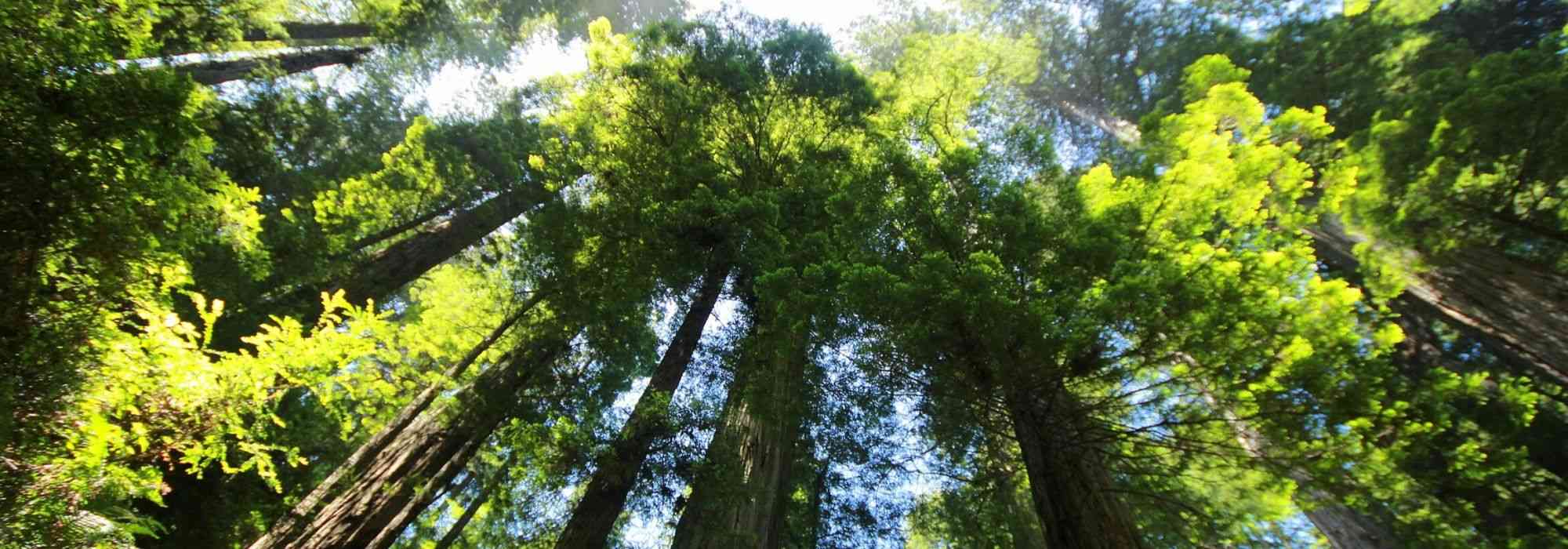
Sequoias and Sequoiadendrons: Planting, Pruning, and Care
Contents
Sequoia and Sequoiadendron, in a nutshell
- These giant North American conifers, dating back to ancient times, dominate most of the large parks in Europe.
- These trees prefer deep, cool, rather acidic soils, a humid climate year-round, warm in summer, and fairly mild in winter.
- Their majestic conical or pyramidal habit transforms into a somewhat fantastical weeping form in Sequoia giganteum ‘Pendulum’, and the ‘Glaucum’ variety stands out for its foliage and branches with intense grey-blue reflections.
A word from our expert
Under the name of sequoias, two giant conifers belonging to distinct genera are designated: Sequoiadendron giganteum (“Giant Sequoia”) and Sequoia sempervirens (“Coast Redwood” or “Yew-leaved Sequoia”). These trees can easily reach heights of 100 m in their North American habitat, but currently, they are limited to about fifty metres in our latitudes. However, their introduction dates back only to the 19th century, so we are dealing with adolescents, knowing that their longevity can reach 3,000 to 4,000 years.
The Sequoia sempervirens or “Yew-leaved Sequoia” is a persistent conifer that holds the height record (110 m) in its natural habitat. Its foliage resembles that of a fir or yew, with flat needles arranged on either side of the branch. The dark green colour of its branches contrasts with its imposing trunk, protected by thick bark that is soft to the touch and tinged with reddish-brown. The entire tree exudes an extraordinary resinous fragrance. The tree widens a bit with age, extending its branches in a graceful movement that gently guides them towards the sky at their tips.
The Sequoiadendron giganteum or “Giant Sequoia” has a slightly faster growth rate and greater resistance to cold, particularly against spring frosts. Its trunk is thicker than that of the Sequoia sempervirens, and its overall habit remains almost columnar, with foliage taking on a hooked shape. Its rot-resistant wood is, however, less valued for construction than that of its counterpart known as the “redwood tree” in English. There is a cultivar ‘Glaucum’ with intense grey-blue foliage.
They are promised a bright future (over 3,000 years!) if they have enough space. Keep that in mind!
Description and Botany
Botanical data
- Latin name Sequoia, Sequoiadendron
- Family Cupressaceae
- Common name Giant Sequoia, Yew-leaved Sequoia or Evergreen
- Flowering between February and April
- Height between 30 and 50 m in our area
- Exposure sun or partial shade
- Soil type any deep, rich, well-drained soil, even slightly calcareous
- Hardiness Good to excellent (-12 to -25 °C)
The generic term sequoia refers to two species of North American conifers, classified in distinct genera: Sequoiadendron giganteum and Sequoia sempervirens. There is also the genus Metasequoia to designate the Sichuan Sequoia native to China. All these conifers, discovered less than 250 years ago, belong to the family Cupressaceae according to phylogenetic classification, formerly Taxodiaceae. Their existence on Earth dates back to the time of the dinosaurs, and their habitat also extended to Europe and Asia before the Quaternary glaciations decimated them.
These two conifers are among the tallest trees on Earth, with trunk heights exceeding 100 m. In France, the height record goes to the European Silver Fir (Abies alba), which reaches 52 m. However, the Giant Sequoia has a more massive trunk and a faster growth rate than the Evergreen Sequoia. It populates the western mountain slopes of the Sierra Nevada, such as Yosemite National Park in California, which receives over 2,000 mm of precipitation annually. It is much less sensitive to late frosts than young Sequoia sempervirens, which often regenerate from the stump and form multiple trunks after being affected by frost. This latter species occupies a narrow band 730 km long and a few dozen kilometres wide along the Pacific coast from California to southern Oregon, at low altitudes (30 to 750 m). You can admire a beautiful sample north of San Francisco at the John Muir Woods National Monument.
Their longevity is equally impressive, reaching 3,000 to 4,000 years. This is partly explained by the quality of their very thick, fire-resistant bark, which allows them to survive fires. Intense heat is indeed necessary to trigger the opening of the cones, leading to the release of seeds that only germinate on recently burned soil. The reddish bark, very fibrous, is easily recognised by its very soft texture to the touch and its deep interlaced fissures. It can measure up to 60 cm in thickness!
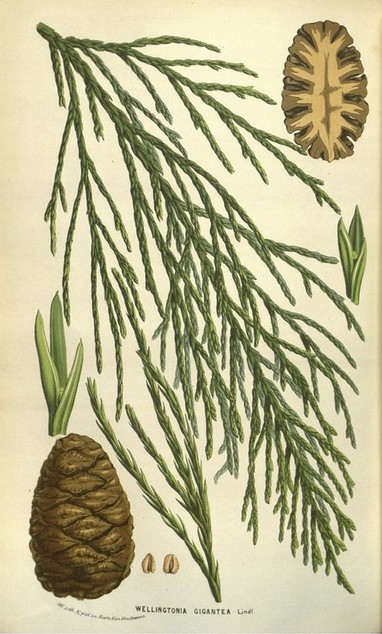
Sequoiadendron giganteum – botanical illustration
The Giant Sequoia has a deep, taproot system, allowing two giant trees to grow 2 m apart without really hindering each other, especially since roots tend to connect with one another to better explore the soil. Its counterpart, the Evergreen Sequoia, spreads both in width and depth but without a taproot, making it more sensitive to drought periods. However, these trees have the particularity of absorbing a large amount of water through their foliage (30 to 40% of the water in S. sempervirens) which explains their preference for misty climates, shrouded in fog and the disproportion between the root and aerial volume of these giants (6% of the total mass of the tree in S. giganteum).
The foliage of Sequoia sempervirens is quite typical, with dark green, flat needles, 2.5 cm long, arranged in two ranks like those of yew or the Vosges fir. In contrast, the needles of Sequoiadendron are rather atypical. They are scale-like, hook-shaped, reaching 3 to 15 mm, arranged all around the branch, providing a rather soft touch reminiscent of plastic. They resemble the needles of Japanese Cryptomeria, known as “in alène,” but are shorter and can also be recognised by their aniseed scent. Their grey-green hue is more bluish in the ‘Glaucum’ form. It is quite easy to observe the foliage of the sequoias, even if the first branches are inaccessible, as the tree undergoes a decurtation process, shedding some of its fine, leafed branches after browning, which end up littering the ground.
Flowering does not occur at exactly the same time. The pollen contained in small terminal aments of the Evergreen Sequoia is released in February, while that of the Giant Sequoia is released in March-April. These trees are monoecious, bearing male and female cones on the same individual, but it often takes several hundred years for them to be observed. The Evergreen Sequoia (the height record holder) has very small cones measuring 15 to 25 mm long, while the Giant Sequoia has ovoid cones measuring 3 to 7 cm long. The latter can remain on the tree for up to 20 years before releasing their seeds, but they often persist on the tree even after their work is done.
The wood of very old sequoias has been extensively exploited, particularly during the gold rush, which explains the significant reduction in the area of these forests. The creation of national parks was necessary to protect these millennia-old trees. The wood of Sequoia sempervirens, known as “redwood,” is the most prized, especially for covering house facades in the United States; it is heavy, very hard, rot-resistant, and resin-free, while the Giant Sequoia has porous, lightweight wood that is also resistant to insects.
The buds of the Giant Sequoia are used in gemmotherapy to strengthen bones, support prostate health, enhance urinary comfort, and boost male vitality.
The main varieties of Sequoia
Varieties of Sequoiadendron giganteum
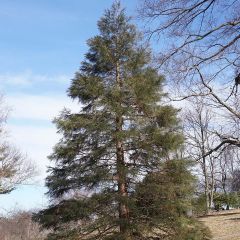
Sequoiadendron giganteum
- Height at maturity 65 m
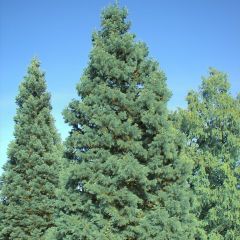
Sequoiadendron giganteum Glaucum
- Height at maturity 35 m
Varieties of Sequoia sempervirens
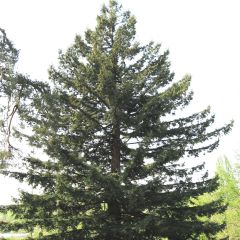
Sequoia sempervirens - Yew-leaved sequoia
- Height at maturity 50 m
Discover other Sequoia
View all →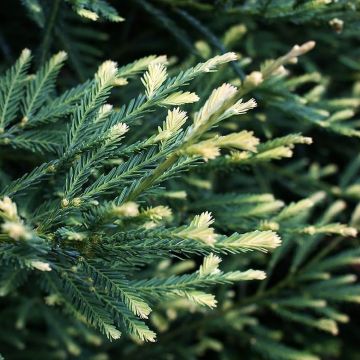
Available in 1 sizes
Available in 1 sizes
Available in 1 sizes
Available in 2 sizes
Available in 2 sizes
Planting
Where to Plant the Sequoia?
Take advantage of the cool, moist climate of the Atlantic coast to install the evergreen Sequoia, destined to live for many years. It is quite sensitive to late frosts that often cause the leading shoot to die, resulting in the growth of multiple trunks, but in any case, the tree subsequently offers very good cold resistance. An ideal location is along a river, sheltered from the wind and not too exposed to spray, for planting the yew-leaved sequoia. This species tolerates limestone better than Sequoiadendron.
The giant sequoia, which has a slightly faster growth rate, appreciates warm summers and snowy winters that provide a protective layer for the roots. It demands full sun from the moment of planting, while Sequoia sempervirens enjoys the shade of a bush in its early years and requires a bit more moisture and gentleness in winter.
They adapt to all types of well-drained, fairly fertile soil that is not too calcareous, with a depth of at least 1 m.
The taproot system of the giant sequoia makes transplanting delicate, so it is preferable to opt for a young tree that will soon exceed the height of a house.
When to Plant?
Prefer autumn, from September to November, or spring, from February to June, to install your sequoia.
How to Plant?
This tree is easy to cultivate if you have a large space. The branches form a columnar or pyramidal crown 8 to 10 m wide, and growth is quite rapid (4-5 m high after 10 years for the giant sequoia). There are also medium vigor forms like Sequoia giganteum ‘Pendulum’, which has a spread of no more than 1.5 to 2 m for a height of 10 to 12 m.
- Soak the pot in a bucket of water to thoroughly moisten it.
- Dig a wide hole to remove stones and check for the absence of debris below that may hinder its growth.
- Avoid planting a sequoia less than 50 m from the house. Plant it in isolation or form a grove by spacing the subjects about ten meters apart.
- Add a good amount of compost and crushed horn to enrich the soil.
- Install 3 sturdy stakes around the hole if your subject exceeds 1 m in height and tie the trunk to the 3 stakes with soft ties that will allow for good root anchorage.
- Replace the soil, forming a basin.
- Lightly compact and water generously.
- Mulch.
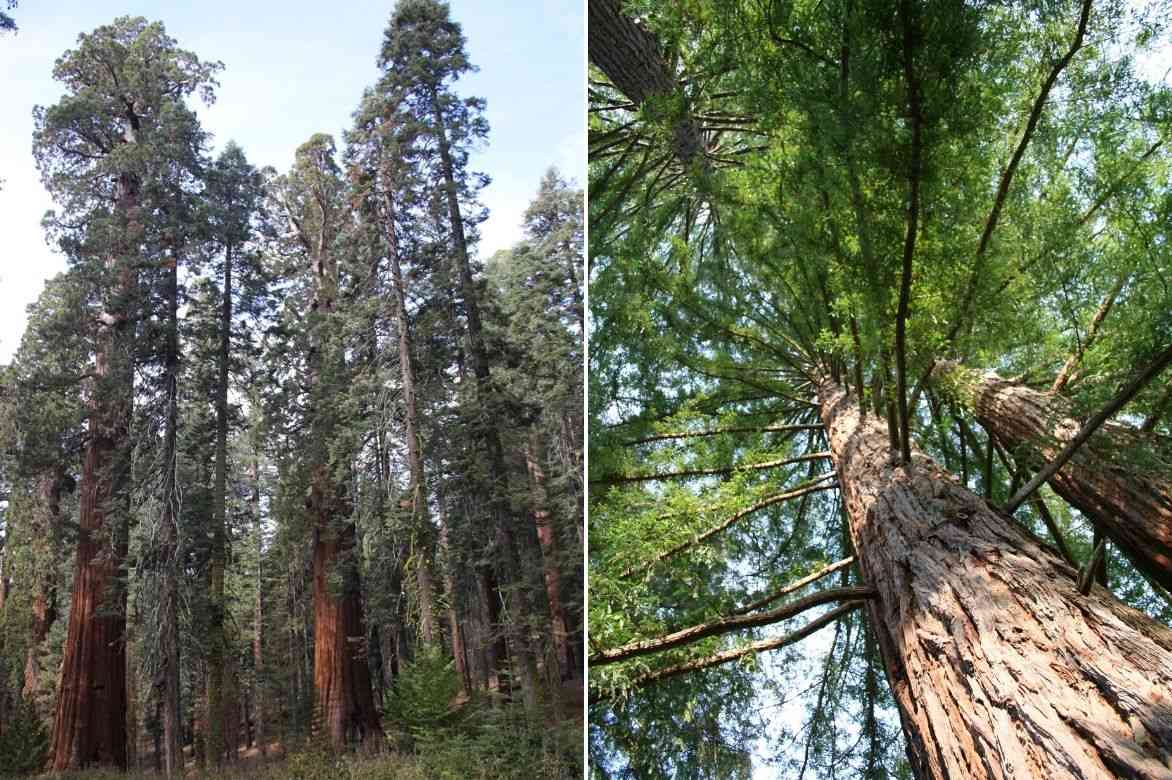
Sequoiadendron sempervirens
Maintenance and Pruning of Sequoias
- Ensure to water the young plant well during the first few years and in case of prolonged drought.
- Brown spots on the leaves are not serious. Sea spray can sometimes cause browning of the branches after a heavy storm, but the tree will recover.
- To enhance the compact habit of this tree, a very light annual pruning can be carried out from September to November, shortening only the shoots of the year that are deemed unsightly.
- Remove the suckers from the trunk of the evergreen sequoia to maintain a single trunk. However, it is wise to keep at least one, which could replace the leading shoot in case of frost.
Propagation by cuttings: multiplication
Sowing is not easy, especially with the Giant Sequoia. Studies have shown that only 13% of seeds are viable and that germination occurs in only 84% of them. The presence of cones appears late, on trees reaching 25-30 m in height, exceptionally on young specimens under stress, but their smaller seeds are rarely viable. Purchasing seeds of sequoia guarantees more success (between 15 and 50%).
Propagation by cuttings is therefore recommended: in spring, using herbaceous cuttings, or in summer, using semi-woody cuttings.
Propagation by Cuttings
Prepare a pot deep by filling it with potting soil mixed with sand.
- Take tips of shoots with a heel (torn bark end) if it is the Yew-leaved Sequoia and simple if it is the Giant Sequoia.
- Remove the leaves near the base of the cuttings.
- Insert them two-thirds of their length, ensuring they do not touch each other.
- Gently firm the soil around to eliminate air pockets and ensure good contact between the potting soil and the cutting.
- Place them in the shade.
- In autumn or later, separate the rooted cuttings and plant them in a deep pot, which you keep under a frame until spring.
- Plant your young plants in spring in the open ground.
Uses and Associations
The Sequoia requires a sufficiently large space, away from overhead and underground networks, to have a chance of enduring through generations. If the conditions are right, it will indeed become an exceptional tree, a source of pride for the gardener who planted it, undoubtedly outliving them and fully integrating into the history of a family and a garden. It can be planted as a solitary specimen to draw the eye, in pairs, on either side at the start of a grand avenue, or form a regular alignment in an exceptional setting such as the entrance to a castle or sanctuary. The giant Sequoia can also easily fit into a hedge of large conifers as its roots primarily extend deep, marking the boundaries of the countryside, for example. A curtain of giant bamboo, Phyllostachys bambusoides, provides an original backdrop to the presence of one or more Sequoias.
The fastigiate varieties, such as Sequoia giganteum ‘Pendulum’, which are less vigorous, are a curiosity that should be planted as solitary specimens. The latter produces very short, trailing branches that are tightly pressed against the trunk, with a leading shoot that is inclined.
Did you know?
Sequoiadendron giganteum and Sequoia sempervirens are two trees reaching heights of 100 to 110 m, the height long accepted as the maximum for allowing sap to nourish the top of the tree. However, Eucalyptus regnans holds a record of 132.60 m. Among our two sequoias, Sequoia sempervirens holds the height record with a specimen named Tall Tree, measuring 115.50 m and aged 600 years, located in Red Wood National Park, while the giant sequoia Sequoiadendron giganteum holds the trunk volume record. General Sherman, at 3,000 years old and 84 m tall, has a circumference of 32 m and an estimated weight of 5,500 tonnes! A box made from its trunk could hold a cruise ship!
- Subscribe!
- Contents
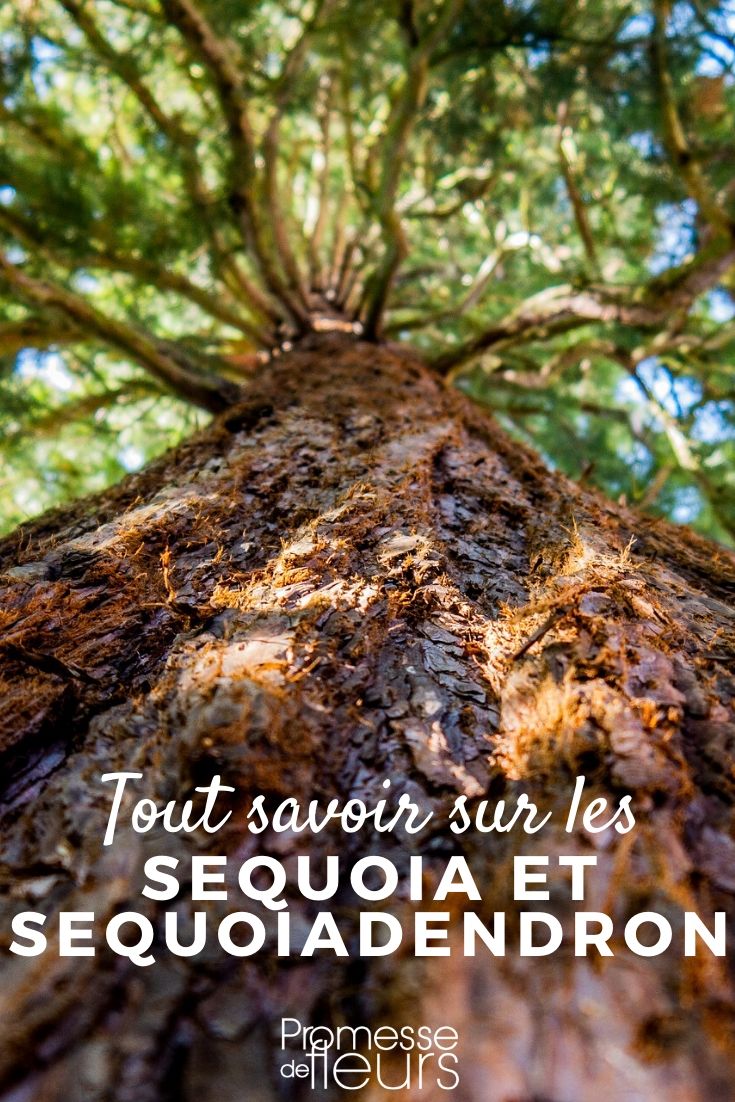































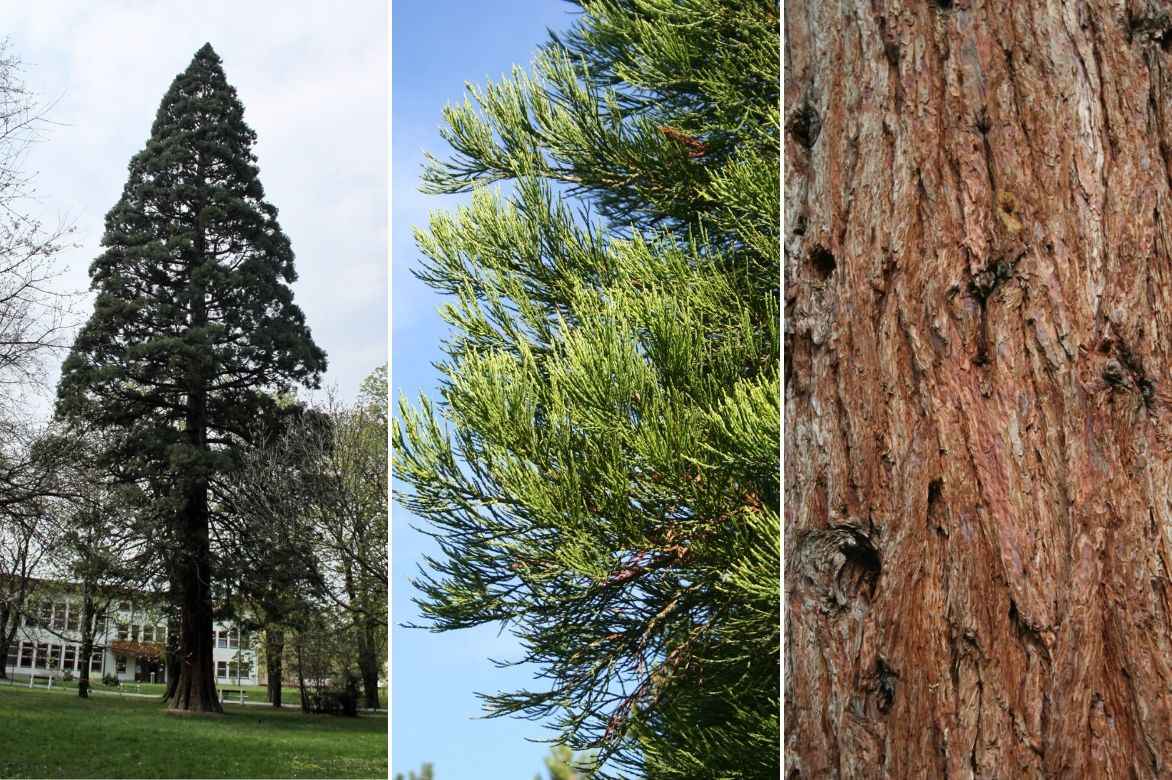

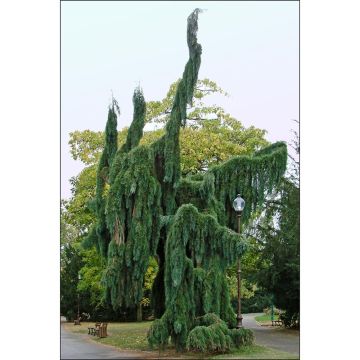


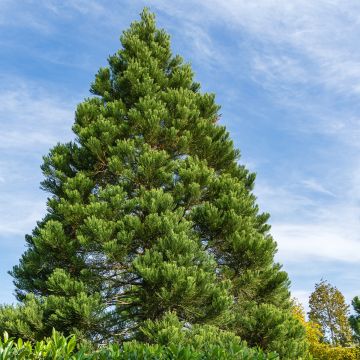
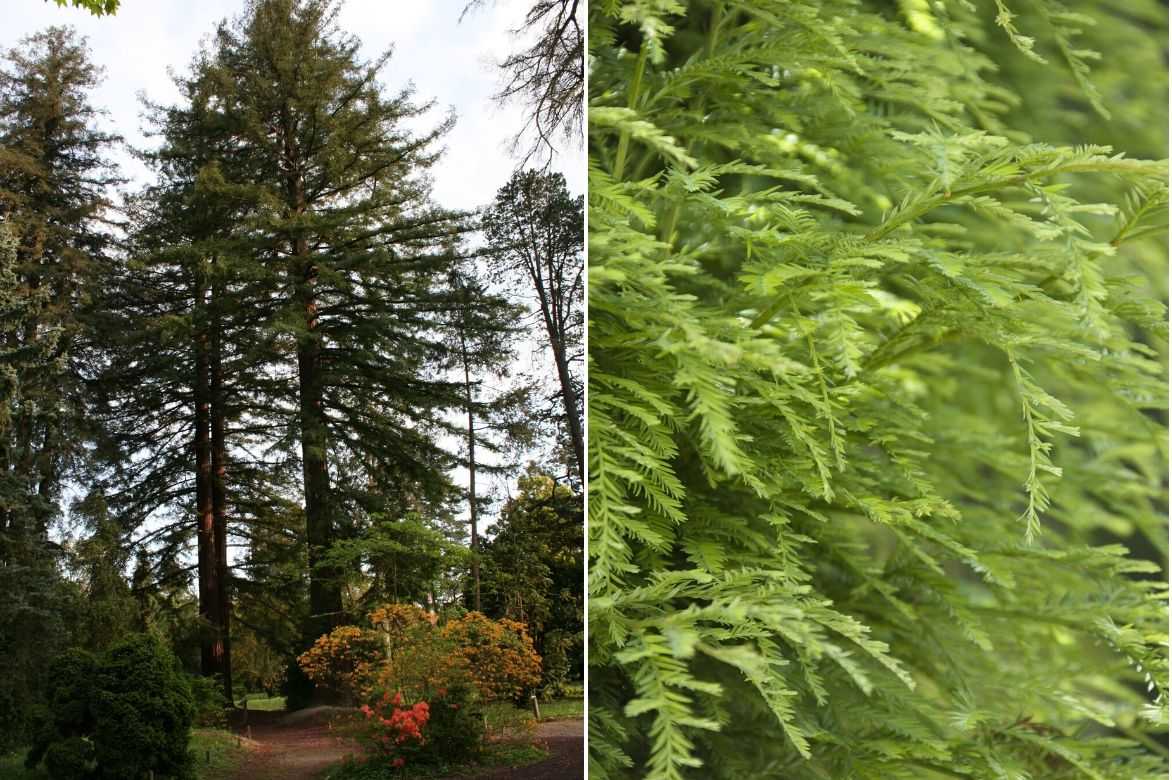
Comments